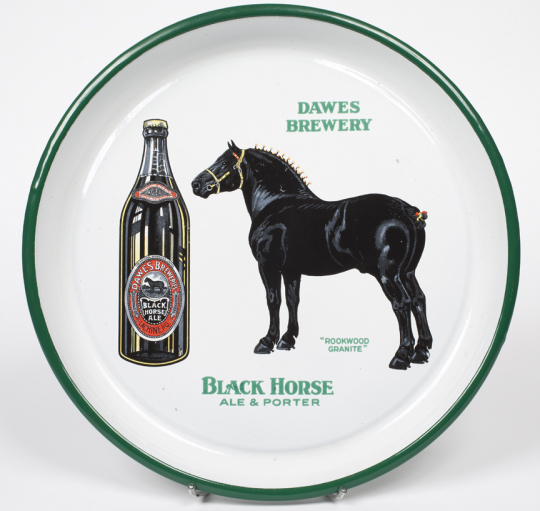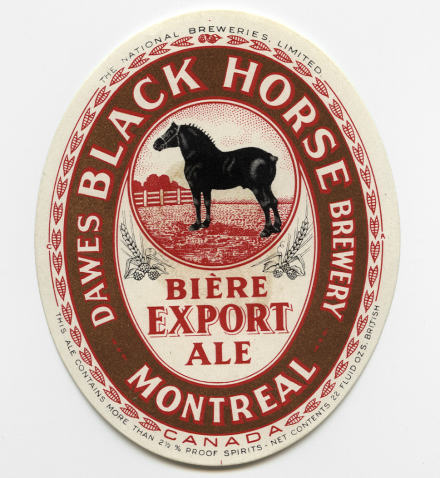
Today is the birthday of James Pawley Dawes (July 17, 1843-June 11, 1907). He was the grandson of Thomas Dawes, who immigrated from England to Lower Canada in 1808 and three years later established the Dawes Brewing Co. in Lachine. His father and uncle ran the brewery after his grandfather passed away, and then J.P. and his brother took over, and it remained in the family until 1952.

This biography is from the Dictionary of Canadian Biography:
James Pawley Dawes’s grandfather Thomas Dawes immigrated from England to Lower Canada in 1808 and three years later established a brewery in Lachine. After receiving his early education in Montreal, James Pawley journeyed to England, where he became an apprentice in the brewing trade at Evershed, near Burton upon Trent. He returned to Lachine to work in the family brewery and on the death of his father in 1878 inherited, with his brother Andrew Joseph, his father’s share in the business. Together with their uncle Thomas Amos Dawes, the two brothers directed the enterprise. The Daweses’ establishment was one of the major breweries in the Montreal area. In 1863 its output was the second highest, ahead of that of Molson’s Brewery but behind that of the leading producer, William Dow and Company. Its offices were on Rue Saint-Jacques, Montreal, but production remained concentrated in nearby Lachine, where by the early 1880s the firm had a complex of buildings on Rue Notre-Dame and at least 370 acres of land to grow barley and hops. In 1909 the Dawes brewery would join with several others, including the Dow brewery, to become National Breweries Limited. Dawes ceased brewing operations in Lachine and relocated in Montreal. While the other breweries involved in the merger were closed, both the Dawes and Dow breweries continued to function. In 1952 Canadian Breweries Limited was to purchase National Breweries and change its name to Dow Breweries Limited.
The prominence of the Dawes family in the relatively small community of Lachine extended beyond their brewery and landholdings. James Pawley was a jp in nearby Caughnawaga (Kahnawake), Thomas Amos was a jp in Lachine, and Andrew Joseph was for many years a municipal councillor and mayor of Lachine. James Pawley was the family member at the forefront of entrepreneurial activities to promote the development of Lachine. He initiated the building of the first telegraph line from Montreal to Lachine and in 1882 helped the Dominion Bridge Company Limited, founded that year by Job Abbott, locate a 24-acre site for its works. The town council, which included Andrew Joseph, was undoubtedly acutely aware of the economic impact of such a large industrial enterprise and offered subsidies and tax incentives to help attract it, in exchange for guarantees of investment and employment for local residents. Although the company’s earliest successes rested on the construction of railway bridges in the Montreal area, the business soon expanded to include the construction of bridges and structural-steel buildings across Canada.
Dawes was a major shareholder of the Dominion Bridge Company. He served on its board of directors from 1890 to 1892 and as vice-president from 1893 to his death, during the period when it became a national enterprise. In the frequent absences of its president, James Ross, Dawes chaired the monthly meetings. Although Ross was the driving force behind the company, Dawes brought special skills to bear as a negotiator in the political arena. He scored his greatest coup as a lobbyist on the company’s behalf in 1890, meeting with Quebec premier Honoré Mercier and members of his cabinet to persuade the government to stop giving preferential treatment to Belgian bridge contractors. Thereafter the Quebec government shifted most of its bridge-building business to the Dominion Bridge Company.
From 1886 to 1907 Dawes was on the board of directors of another national institution, the Merchants’ Bank of Canada, owned largely by the Allan family. The bank held large investments in railways and government debentures, including those issued by the town of Lachine. Dawes was less active in the bank than in the Dominion Bridge Company, but he regularly attended directors’ meetings. His diverse business interests also included a directorship in the Alliance Assurance Association of Canada and the presidency of the board of directors of Montreal’s prestigious Windsor Hotel.
Dawes’s wealth provided him with time to pursue other activities. Sports, especially horse-racing, seem to have occupied at least as much of his time as his business interests. Moreover, he was as prominent a sportsman as he was a businessman. He was a member of the Montreal Hunt Club and in his youth had participated in many hunting meets. Around 1900 he joined business associate Hugh Montagu Allan in an effort to revive steeple-chasing within the club. He established his own racing stable, Maplewood, in Lachine. Entries from his stable were quite successful in flat-racing and over steeplechase courses, in both Canada and the United States. His horses won the Quebec version of the Queen’s Plate on 11 occasions, and were often raced at Saratoga Springs, N.Y. Active in horse-racing organizations, he was an important participant in Lachine’s Bel-Air Jockey Club, serving during the 1890s as vice-president and president. In 1899 he helped organize Quebec’s Queen’s Plate at the Bel-Air club and invited Governor General Lord Minto Elliot and Prime Minister Sir Wilfrid Laurier to attend.
Dawes’s other major sporting activity was sailing. A member of the Royal St Lawrence Yacht Club, he often entered his yacht the Surprise in regattas held on Lac Saint-Louis. He was also a member of the Forest and Stream Club in Dorval and the Royal Montreal Golf Club.
James Pawley Dawes’s career centred on Lachine, where his family had made extensive investments and the town’s economic development was his main concern. Through his involvement in such sectors as banking, insurance, and, in particular, manufacturing, he was able to move beyond a purely local economy to become involved in ventures of national importance. His entrepreneurial success was probably the result of equal measures of readily available capital, personal initiative, and his standing as a member of a notable local family. As a successful manufacturer, on an equal footing with the élite of the Montreal business community, Dawes also had the opportunity to build another successful career as a sportsman.

This biography of Dawes is from the Musee de Lachine website in Montreal, Quebec’s exhibition on Black Horse Beer entitled “Pour boire il faut vendre” (To get a drink you have to sell):”
Born in Ambleside, England, Thomas Dawes (about 1775-1863) was the eldest of six children. He arrived in Canada in his early thirties, in 1808. In 1811, he settled in the area of Montréal called Côte des Argoulets (today’s Verdun borough), where he found work at a brewery run by Joseph Chapman. The brewing business suited him, it seems, since it became his lifelong career.
Thomas Dawes married Charlotte Weller in 1817, with Joseph Chapman and James Ogilvie as witnesses. The Dawes and Ogilvie families appear to have been friends. The connection was confirmed a few years later when, on April 21, 1826, Thomas Dawes and his associate Archibald Ogilvie bought from Stephen Finchlay a parcel of land southwest of Montréal, near what is now 28th Avenue in Lachine. Banking on his experience, Dawes set out to operate a farm and a brewery on the 4-acre by 30-acre lot.

This account of the brewery and the Dawes family is a Google translation from “Historie du Quebec:”
The name Dawes evokes one of the most famous breweries in Quebec. It was in 1811 that Thomas Dawes founded the Dawes Brewery, which was Lachine’s first industrial enterprise. Dawes is the third brewery on the island of Montreal, after the Molson brewery , founded in 1786, and the Dunn brewery , which appeared in 1809.
The Dawes Brewery is a family business, and no less than four generations of Dawes manage it, before selling the company to Canadian Breweries .
After Thomas Dawes, his sons James P. Dawes and Thomas A. Dawes took over. The third generation is represented by Andrew J. Dawes and James P. Dawes Jr. The fourth, by Norman Dawes, who has run the brewery for decades. But he sold it in 1952.
The Dawes were involved in the development of Lachine. Indeed, Thomas A. Dawes was mayor of Lachine from 1868 to 1869, while Andrew J. Dawes held this position from 1888 to 1893. It was the Dawes who funded the foundation of the Lachine General Hospital and of several churches , the tram network and the installation of the first Lachine telegraph line.
In addition, the Dawes family was among the founders of the Société d’Assurance Automobile du Québec , created in 1904 under the name of the Automobile Club of Canada . Andrew J. Dawes also headed Bell Canada, the Merchant Bank and other large companies. In addition, the Dawes imported and raised black percherons and contributed to the improvement of this horse breed. It will be remembered that it was Percherons who ensured the delivery of the beer and that they thus became the symbol of the Dawes brewery thanks to Black Horse beer .
In 1862, the Dawes built their imposing family home in Lachine (which was not sold until 1940). Around the Dawes area, large fields were devoted to the cultivation of barley and hops.
The decline of the Dawes brewery began in 1909, when sixteen Quebec breweries merged into the National Breweries Ltd. consortium. But the Dawes Brewery survived this ordeal, even if the company felt the effects of American prohibition in the 1920s. In 1939, it became the Dawes Black Horse Brewery, recalling its most famous beer.
In 1944, the Dawes proposed a merger with Molson, but the latter refused for fear of establishing a monopoly. The National Breweries Ltd. consortium was finally sold in 1952. It was bought by Canadian Breweries . The group is renamed Dow Brewery (moreover, the Dow Brewery had already existed for years, it was the designation for the whole consortium). The Dawes Black Horse Brewery disappears, as does the great Dawes dynasty. The Dow has long become one of the most popular brands among Quebecers, but that’s another story.



